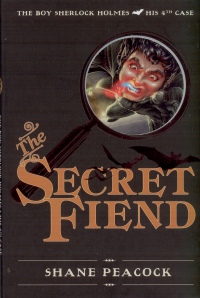| ________________
CM . . . . Volume XVII Number 2. . . .September 10, 2010. 
 |
The Secret Fiend. (The Boy Sherlock Holmes, Bk. 4).
Shane Peacock.
Toronto, ON: Tundra Books, 2010.
244 pp., hardcover, $21.99.
ISBN 978-0-88776-853-8.
Subject Heading:
Holmes, Sherlock (Fictitious character)-Juvenile fiction.
Grades 6-10 / Ages 11-15.
Review by David Ward.
****/4
|
| |
|

Victorian England had its share of crime. London was infamous for its urban myths and sensational penny book characters. Unsolved murders and mysteries abounded on its dark and often foggy streets. One of the legends that came into being in the late 1830’s was the story of the Spring-Heeled Jack. Eyewitness accounts at the time described a tall figure in a cape with remarkable leaping capabilities. Further, witnesses said the figure spouted blue flame from his mouth and had red eyes. The Spring-Heeled Jack was reported to have attacked several women.
Using this urban legend as a background, Shane Peacock has once again created an intriguing, well-crafted mystery for the young Sherlock Holmes.
It appeared out of nowhere, leaping from a bank of the River Thames onto Westminster Bridge one dark, London night like a man endowed by the devil with superhuman powers. Two servant girls, walking arm in arm and frightened by the late hour, barely turned before it was on them. It gave a shriek and then did its deed, ripping one from the other and making off with her across the cobblestones, reaching the other side of the wide bridge in just a few bounds. There, it sprung up onto the balustrade, the limp girl in its arms, and jumped out into the night, its wings fluttering in the cold air as though it were a human bat escaped from the underworld. They struck the freezing water with a crash and the night was silent again, interrupted only by the frightened sobs of the other girl prostrate on the stones. Then she rose and ran as hard as she could, northwards, toward Denmark Street.
Familiar characters return in The Secret Fiend, young Sherlock;s fourth case; Lestrade the younger, Irene Doyle, Malefactor, and my personal favorite and Holmes’ mentor, Sigurson Bell. Bell’s outbursts of enthusiasm are unquenchable. In one sequence regarding the art of self-defense, he cries:
“You must seize him by the unmentionables.”
“I beg your pardon?”
“His meat and vegetables, his cricket equipment, his private machinery!”
“Sir?”
“Seize them!” The old man leaps at Sherlock, hand out like a claw, his face as red as a rose. Sherlock turns and runs from the room.
“My boy! Come back! I intended to inflict no pain upon your actual person!”
Peacock has also woven the politics of the era into the story, once again making his boy Sherlock Holmes mysteries an excellent choice for period reading and Social Studies courses. Sherlock’s awareness of self and his growing into manhood are tactfully treated. Sherlock flushes when interviewing the attractive Beatrice and wrestles with his feelings as he tries to be both a detective and a friend. There are numerous female characters, more than in the last stories, both strong and likable, which provides a good sense of balance for readers. I found the fourth book in the series enjoyable, thoughtful, and once again, an allure into the Victorian world of Holmes and London.
Highly Recommended.
David Ward is a children's author and assistant professor at Oregon's Willamette University.

To comment on this title or this review, send mail to
cm@umanitoba.ca.
Copyright © the Manitoba Library Association. Reproduction for personal use is permitted only if this copyright notice is maintained. Any other reproduction is prohibited without permission.
NEXT REVIEW |
TABLE OF CONTENTS FOR THIS ISSUE- September 10, 2010.
AUTHORS |
TITLES |
MEDIA REVIEWS |
PROFILES |
BACK ISSUES |
SEARCH |
CMARCHIVE |
HOME |
